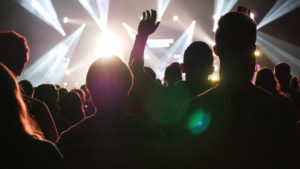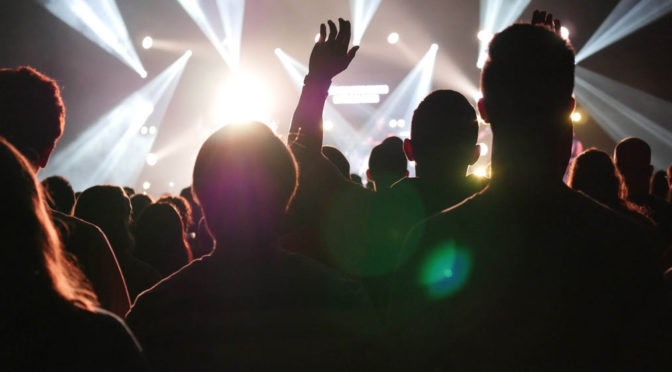 In a loud stage environment, musicians become accustomed to hearing their monitor mix at high volume. Some use in-ear monitoring systems (IEMs) to reduce the impact, but if the volume on the device is not regulated and lowered, it’s no solution. IMEs are only considered protective devices if they are used at safe levels.
In a loud stage environment, musicians become accustomed to hearing their monitor mix at high volume. Some use in-ear monitoring systems (IEMs) to reduce the impact, but if the volume on the device is not regulated and lowered, it’s no solution. IMEs are only considered protective devices if they are used at safe levels.
IEMs are in demand because they isolate the ear from ambient noise and artists can hear the intended signal clearly, at a much lower volume. Critical to the equation, though, says Michael Santucci, Au.D., a researcher and expert who specializes in hearing conservation, is much lower volume. It requires modifying user behavior and listening patterns.
Look no further than the iPod. Studies have shown, in case after case (especially with teenagers), that there was irreversible damage because of volume and prolonged listening. Do most musicians use ear protection? “No,” says Santucci, “Are attitudes changing? Absolutely.”
It’s like sun exposure, he explains: it’s both how strong it is and how long you’re exposed. In music, it’s personal susceptibility, how loud, and how many hours you’re in it. “We do pit crews for Broadway plays. Is it terribly loud? Not always, but they’re doing it six hours a day.” Nowadays, Santucci frequently works with orchestras because they are featuring more pop stars. The added decibel (dB) quotient can be deafening to orchestra members. Santucci says, “Risk goes up with volume and length of exposure.”
A recent study out of Vanderbilt University showed that, regardless of whether they used floor wedges or IEMs, subjects turned them up to their usual listening level. Everybody had three days of in-ear and three days of floor wedges at different times and in different venues. Every musician turned to exactly the same loudness every day.
“If you’ve been practicing guitar for years at 110 dB with wedges, the natural tendency will be to turn your IEMs to 110 dB, even if it’s not needed,” Santucci says. “And until the audiologist says you need to turn it down to here, their brains tell them to go back to the level they’re used to.”
The good news is that the second part of the study showed that musicians can recalibrate their brains to listen at a lower level. After a couple of weeks, it becomes the norm. Santucci says, “It’s habit—like the timbre of your instrument, pitch—it’s all because you’ve done it a million times. Loudness goes right along with it.”
Adding Ambient Sound
Some musicians say they feel disconnected from the band and the crowd with IEMs. This can be addressed in a few ways. The trick, Santucci says, is to do so without compromising the isolation of the IEM system. A simple remedy is for the sound engineer to set up audience mikes to add to the monitor mix so the artist can get a feel for the room. “Some musicians take out one IEM, which is very damaging to hearing. They end up turning up the side with the ear monitor even louder, plus they have an open ear not protected by anything.”
For a natural, but more robust, method of adding ambient sound into the IEM mix, Santucci recommends 3D active ambient IEM systems that allow the musicians to control how much ambient sound is heard. “What I do not recommend is porting the earphone to let ambient sound leak. Porting effectively eliminates the benefits of isolation and cannot be controlled, it has the potential for the user to turn up the volume of the system to unsafe levels.”
Safe Listening
For hearing conservation benefits of in-ear monitors, refer to OSHA and NOISH guidelines to determine exposure times for safe use. Shows of less than one or two hours are less of a problem. For a club band, whose shows may go on for several sets of three or more hours, volume levels must be much lower and should average no more than 95 to 97 dB.
The problem is being able to accurately determine the decibel level coming from the in-ear monitors. Currently, the only method to measure these levels is with ear-probe microphone technology used during rehearsals or sound checks by an audiologist. From these readings, a volume level can be recommended based on the length of a show.
Tinnitus and Hearing Loss
If your ears ring or if you have trouble hearing after a concert, you are definitely in danger of noise induced hearing loss (NIHL). Santucci cautions, “Even if your ears don’t ring, if you think it’s safe, you’re wrong. Research shows that, of those suffering from NIHL, only 30% experienced ‘ringing’ as a warning sign. In other words, if your ears ring after a performance, you’re too loud. But if they don’t ring, there’s a 70% chance you may still be damaging your ears, if levels exceed OSHA safe exposure limits.”
For additional information, visit the websites: www.osha.gov/SLTC/noisehearingconservation or www.cdc.gov/niosh.
Other Hearing Protection Tips:
- Invest in superior hearing protection,
custommade ear molds with dampening filters.
Preferably use musicians’ earplugs, which offer flat attenuation vs. traditional earplugs, which tend to filter sound from higher frequencies, resulting in a muffled sound. - Protect your ears consistently every time you may be exposed to loud music and/or sounds, not just when you are performing.
- Better yet, avoid noise as much as possible when you are not performing.
- Invest in high-quality in-ear monitors and train your ears to use the lowest level that’s feasible.
- Drummers should use dampening pads when possible.
- Sound travels in a straight line so it’s louder directly in front of or behind a speaker. Spread out so you are not being blasted by the musician next to you. Move away from on-stage monitors and amplifiers.
- If moving away is not an option, look into using baffles to protect yourself.
- Take breaks of 15 minutes in between sets of music or rehearsals to give ears a rest. During rest periods go outside or somewhere quiet.
- Whenever possible, practice at lower volume
or play your electrified instrument unplugged. - Use smaller amps when possible.
- Avoid ear buds and other direct-injection earphones for recreational listening, especially in loud environments.
- Have your hearing tested frequently by an audiologist.
- If it’s not possible to have regular professional sound-level assessments, at least use a sound meter app to check your exposure level.
- Avoid signing up for repeated live gigs at loud clubs. If possible, give your ears some recovery time in between.
Michael Santucci, Au.D. works with the Audio Engineering Society (AES), where he is vice chair of the Technical Committee on Hearing and Hearing Loss Prevention. He operates a Musicians Hearing Clinic and works on hearing conservation through Sensaphonics: In-Ear Monitoring Systems.


